The CASE of Alfred HARRINGTON
CHRIS LONG reprints 1985
Police gazettes
The research we have provided on these weblogs since 2003 about the police work of professional photographer Thomas J. Nevin in Tasmania during the 1870s and the mugshots he produced has stimulated and inspired a global reading public. If you are curious enough to pursue your own detective work regarding the prisoner’s identity in this handful of the few remaining mugshots yet to be documented (see below), take advice from researcher Peter Doyle. In his latest publication of mugshots from the NSW Justice and Police Museum , Crooks Like Us (2009), Doyle states that the police gazettes were the first he consulted and the most reliable source of information (p.312). The equivalent Tasmanian police gazettes are available as searchable CDs (from Gould’s) and are also online at the Archives Office of Tasmania (although not as easily searchable). These police records are by far the most reliable source of information about the 300 extant mugshots which are estrays of more than 1000 originals and duplicates produced by Thomas J. Nevin and his brother Constable John Nevin between 1871 and 1886.


Peter Doyle, Crooks Like Us (2009)
Photos copyright KLW NFC 2010 ARR.
Read more pages in this slideshow: CROOKS LIKE US – click here
Alfred Harrington
Was Alfred Harrington, convicted of manslaughter in 1870, ever photographed for police records, and if not, why not?

Alfred Harrington, absconded and arrested 13 March 1874
Source: Tasmania Reports of Crime for Police, 1874 (weekly police gazette)
TRANSCRIPT
Alfred Harrington, F.C. per Fortitude, 30 years of age, 5 feet 7 inches high, fresh complexion, light brown hair, grey eyes, short nose, small mouth, round chin, stout build, an Englishman, a quarryman. Has relatives at Kangaroo Point and Hobart Town.Alfred Harrington aged 30 yrs, was reported as absconding from Port Arthur and reported as arrested within the week by the Port Arthur police: both reports were published in the same issue of the police gazette Tasmania Reports of Crime on 13th March 1874. He must have received an additional charge for absconding which placed him under a further sentence extending into 1875, despite the remission of his eight (8) year sentence to four (4) years in October 1874 for his murder of David Johnston (or Johnson) at the Mangana mine site (north east Tasmania) in 1870.
The detailed description of Alfred Harrington's appearance in 1874 would assist descendants in identifying him among the handful of prisoners whose mugshots are currently un-named at the Queen Victoria Museum and Art Gallery, Launceston (see below for the black & white copies made at the QVMAG in 1985 from Thomas Nevin's sepia originals taken for police in the 1870s).

Alfred Harrington discharged 21 October 1874
Source: Tasmania Reports of Crime for Police, 1874 (weekly police gazette)
Alfred Harrington was discharged on 21st October 1874, residue of sentence remitted. He was F.C. - i.e. Free to the Colony, arriving as an eleven year (11) old bounty immigrant with his family on the Fortitude from London in 1855. The family group included his parents Robert and Mary Ann, both 43 yrs old; daughters Mary Ann, 20 yrs old and Emma, 5 yrs old; and sons Robert (13 yrs old), Alfred (11 yrs old), John (8 yrs old) and James (2 yrs old).

Top left: Harrington family arrival on the Fortitude, Hobart
Harrington, Alfred
Record Type:Arrivals
Arrival date:15 Feb 1855
Departure port:Plymouth
Ship:Fortitude
Remarks:Age 11
Record ID:NAME_INDEXES:434530
Resource:CB7/12/1/3 BK5
Archives Office of Tasmania
Alfred Harrington, 22 yrs old, married Jessie Price, 19 yrs old, on 25th January 1865 at St, Mark's Church Bellerive, Hobart (Archives Office of Tasmania Resource: RGD37/1/24 no 34). Between 1865 and 1870, Jessie Harrington nee Price gave birth to Joseph (1865), Robert (1867), Alfred (1869) and Frederick (1870). Another son called William was born ca. 1877. A daughter called Dora died on 14th March 1877, six months old, of diarrhea.
The crime committed by Alfred Harrington at Mangana in July 1870 was deeply shocking to those who knew him, to the doctor who attended the victim, to the police when Alfred voluntarily gave himself up, and to the public at large when details of the manslaughter were published. This report, for example, was published in the Mercury on Friday, 15 July 1870, p.2:
MURDER AT FINGAL. -Source: Mercury (Hobart, Tas. : 1860 - 1954), Friday 15 July 1870, page 2
A correspondent writing from Fingal supplies us with the following particulars. He says :" I hasten to acquaint you with the particulars of a melancholy and murderous assault committed by a native of Hobart Town, named Alfred Harrington. From what I have been able to learn it appears that Harrington was working in a shaft that is now being sunk on the Liverpool Company's Claim, at Mangana, along with Mr. David Johnston, formerly a cooper of Hobart Town, but who had lately returned to Tasmania from the Coromandel Gold-fields, in New Zealand, and who was employed by the company, on account of his practical experience as a miner, to superintend tho sinking of the shaft. Both men it appears were working together in the hole when, as it is conjectured, some dispute arose between them and Harrington, being of an excitable temperament, lost all self-control and struck Johnston several times on tho back of the head with his pick. He then left the hole and told several people that he had ' murdered his mate David Johnston, and left him in the hole,' and, no doubt, believing that his victim was dead he went immediately and gave himself up to the police charging himself with having caused Johnston's death. This sad event took place on Monday the 11th instant, and immediately after its becoming known a number of people hurried to the spot, and Johnston, who was quite insensible but not dead, was removed from the hole, and medical aid at once obtained. The doctor has just left him, and states that it is quite impossible that he can recover as his brains are protruding at intervals, and he is fast sinking. He has lost his eyesight, and his limbs are becoming cold. He has not a moment's consciousness since he was discovered, and consequently could not give any account of the sad affair. All Johnston's property has been removed to the Police Office. As the break does not leave till to-morrow morning I will keep my letter open to give you the latest particulars. It is now half-past seven o'clock on Wednesday morning, and Johnston is still lingering, but he cannot survive much longer, though it is possible he may survive till the evening." A telegram was received in town yesterday announcing Johnston's death.
The next day, July 16th, the Mercury published a letter signed "A. Tasmanian" informing the paper that Alfred Harrington was not a "native of Hobart Town" - the usual description of someone locally-born which distinguishes them from arriving as a convicted criminal - and that he had arrived on the Fortitude 16 years earlier. The reporter at the Launceston Examiner, writing from the Police Office on the same day (Saturday 16 July 1870, page 4), went into the grisly details of the attack by Alfred Harrington on David Johnston (or Johnson):
POLICE OFFICE, JULY 14. (Before Thomas Ransom, Esq., J.P.,Warden.) Alfred Harrington was charged that he did at Mangana, on 11th May, 1870, feloniously assault David Johnson, with intent to kill and murder him. The Superintendent of Police applied for a remand, which was granted for seven days. The prisoner was brought up on the above charge because his victim still lives, and although utterly unconscious, appears to breathe regularly and to be free from pain. I saw him to-day, and he has three terrible wounds on the back of his bead, through which I could see the pulsation of the brain. It is a miracle that he has lived so long. The pick with which the wounds were inflicted is covered with blood at the hammer and there are human hairs sticking to it. One of the blows cut through the hat of the injured man. It is a dreadful affair. The prisoner is a tall, good-looking man of about 35 years of age; fair, quiet, but determined looking, and of great strength. I believe he is tractable and easily managed in gaol, and at the above hearing made no remark, and appeared quite composed. He is by no means such a man in appearance as would be taken to be of a violent disposition, although I believe he has the character of being sullen. It is impossible to communicate with Johnson as he cannot speak, and has not spoken except saying no or yes once or twice. He also is a fine man, and well-known at Mangana. The place where the crime was committed is very lonely, and but for the prisoner giving himself up and saying what he had done, Jonston would have died where he lay. Of course, he was immediately removed to Mangana, but all hope of his recovery is at an end: I expect every moment to hear that he is dead.Source: Launceston Examiner (Tas. : 1842 - 1899) Sat 16 Jul 1870 Page 4 POLICE OFFICE, JULY 14.
Here again are details of Alfred Harrington's appearance which may assist in identifying him in any remaining extant mugshots of un-named prisoners - "tall, good-looking man ... fair, quiet, but determined looking, and of great strength...has the character of being sullen "etc.
Initially reported as a ten year sentence for wilful murder, Alfred Harrington was sentenced at the Supreme Court Launceston on 20th October 1870 to eight years for manslaughter. He was transferred to the Hobart Gaol and discharged from Hobart on the 21st October 1874, having served exactly four years of a ten year sentence. In the course of police routine, he would have been photographed by Thomas Nevin at the Hobart Gaol during incarceration, or at the Mayor's Court, Hobart Town Hall and Municipal Police Office on discharge. His name was not included in the list of prisoners sent to Port Arthur after 1870 and sent back again to the Hobart Gaol which was tabled in the Tasmanian parliament on 9th June 1873. His name was not among those whose earnings were documented at the Port Arthur from 1869-1876 (Conduct PA Registers Con 94-1-2 1873-76 etc) Those men were all photographed by Thomas Nevin at the Hobart Gaol either BEFORE they were sent to Port Arthur (from 1872, after the transfer of prisons from Imperial to Colonial governance) or AFTER they returned to the city gaol in Campbell St. Hobart (from June 1873). And photographed again in most cases when they were discharged. Dozens of mugshots of men discharged in 1874 - as Alfred Harrington was on 21st October - survive in public collections, but Harrington's is either missing, never existed, or survives as one of the several unidentified prints or cdvs. He had no recorded alias in the police gazette notices, so the possibility of his mugshot existing but misnamed is unlikely.
Jessie Harrington nee Price

This notice which reported that - (a) Alfred Harrington was still under sentence at Port Arthur in 1875 and (b) that his wife was missing, supposed to living with a man at O'Brien's Bridge (Glenorchy) - was published in the police gazette on November 5th, 1875, page 174. If Jessie Harrington nee Price was missing in 1875, by March 1877 she was found, up on a charge of deserting one of her children:
CHILD DESERTION. - A young woman named Jessie Harrington, was charged by Mr. Oatley, relieving officer of the Charitable Grants Department, with leaving her child without means of support. The defendant admitted the charge, and pleaded that she had been compelled to go into the country to obtain means of support from the child's father. She promised that in future she would take proper care of the child. On the recommendation of the magistrate, Mr. Oatley withdrew the charge.Source: Mercury (Hobart, Tas. : 1860 - 1954), Saturday 3 March 1877, page 3
Jessie Harrington was born ca. 1846, married Alfred Harrington in 1865, and gave birth to his four sons between 1865 and 1870. She had another a son called William ca. 1876 and a daughter Dora who died at 6 months in March 1877. William was the child she left with the Charitable Grants Dept. The warrant for her arrest was issued on 17th February, 1877. She was arrested on 2nd March 1877, per these notices in the police gazette:

TRANSCRIPT
WARRANTS ISSUED, AND NOW IN THIS OFFICE.Warrant for Jessie Harrington's arrest, issued 12 February 1877, pub. 16th.
HOBART TOWN. - On the 12th instant, by John Perkins, Jun, Esquire, J. P., for the arrest of Jessie Harrington, charged with having left her child, William Harrington, without means of support.
Description
About 30 years of age, medium height, brown hair, hazel eyes, a house servant, native of Tasmania.
Source: Tasmania Reports of Crime for Police

TRANSCRIPT
Referring to Jessie Harrington, she is supposed to be living at or about Southport; every effort should be made to effect her arrest....Arrest of Jessie Harrington, 2nd March 1877.
Jessie Harrington has been arrested by Sergeant John Wallace, of the Glenorchy Municipal Police.
Source: Tasmania Reports of Crime for Police
Jessie Harrington was resident in Melville Street Hobart when the death was registered. She died on 29th April, 1886 of phthisis (pulmonary tuberculosis) at Hobart. If she was compelled, as she told Mr Oatley, to seek support from her husband in the country, she was compelled by law. Alfred Harrington's death is not recorded before 1900, but his registration as informant of the death of his one year old nephew, also named Alfred Harrington, recorded him at Waratah, in western Tasmania, site of a large tin mine, in March 1892 ((RGD35-1-61p198j2k), so he most likely returned to mining, although he appears not to have resumed his marriage with Jessie.
So, which of these men whose mugshots remain un-named in the Beattie Collection at the QVMAG, Launceston, most closely fits the descriptions provided by the police gazette and the Mercury journalist?
Is this Alfred - 30 yrs old, tall, fair, good looking, small nose, mouth etc -?

Unidentified Tasmanian prisoner
Black & white copy made in 1985
Sepia original taken by gov't contractor Thomas J. Nevin 1870s
QVMAG Ref: 1985_P_0167
Or is this Alfred - "has the character of being sullen" ?

Unidentified Tasmanian prisoner
Black & white copy made in 1985
Sepia original taken by gov't contractor Thomas J. Nevin 1870s
QVMAG Ref: 1985_P_0162


Thomas Nevin's original sepia prints from glass for police rap sheets
Unidentified prisoners taken at Hobart 1870s
Pasted into one of three panels by John Watt for exhibitions of convictaria 1915
QVMAG Collection: Ref : 1983_p_0163-0176

One of three panels 1915 featuring forty prints of 1870s Tasmania prisoners
Original prints of negatives by T. J. Nevin 1870s
Panels created by J. W. Beattie ca. 1915
QVMAG Collection: Ref : 1983_p_0163-0176
T. J. Nevin at Port Arthur
The group of 109 prisoners who were sent to Port Arthur from 1871 and transferred back to the Hobart Gaol from June 1873 onwards were photographed at the HOBART GAOL by government contractor Thomas J. Nevin. They were NOT photographed at Port Arthur by its Commandant the non-photographer A. H. Boyd, despite circumstantial speculation, wild inaccuracies and ignorance of forensic photography by Chris Long and Warwick Reeder (1990s. The mugshots of the majority of those men tabled as prisoners returning to the Hobart Gaol in June 1873 up to 1876 have survived in public collections. See the lists of names and statistics for those years here. Alfred Harrington's name is not among those on any list.
Thomas Nevin photographed very few prisoners while on site at the Port Arthur prison in May 1874 at the behest of its Commandant-Surgeon Dr Coverdale. Prisoner James Rogers was one of the few whose mugshot is extant (TMAG collection), discharged on 26th May, 1874. Four more prisoners who were received from Port Arthur at the Hobart Gaol and discharged within weeks during January, February and April 1874 - George Fisher, Thomas Francis, John Moran and Thomas Saunders - were all photographed by Nevin at the Hobart Gaol. The rest of those still imprisoned at Port Arthur after May 1874 were either paupers who were not photographed on their transfer to charitable institutions in Hobart, or they were recidivists with on-going sentences who transferred to the Hobart Gaol by the time of the closure of Port Arthur in 1877.
The majority of extant photographs of Tasmanian prisoners ("convicts" in tourist discourse) date from the commencement of Thomas Nevin's government contract in February 1872, with the introduction of pertinent legislation in NSW, Victoria and Tasmania, up to 1886 when he ceased professional photography. The inscription "Taken at Port Arthur 1874" which was written on the versos of 300 or so of Nevin's originals originated from convictarian John Watt Beattie's collection in the early 1900s when they were displayed at his "Port Arthur Museum" in Hobart, and exhibited at the Royal Hotel Sydney in 1916 in conjunction with the travelling convictaria exhibitions on board the fake convict hulk Success. Beattie's collection of Nevin's photographs of prisoners which he had salvaged from the Hobart Goal photographer's room and the Sheriff's Office in 1915, was deposited at the Queen Victoria Museum and Art Gallery in 1927 and later dispersed piecemeal to other public collections (National Library of Australia, the Tasmanian Museum and Art Gallery, the Archives Office of Tasmania and the Mitchell Library SLNSW). It is entirely possible that a prisoner identification photograph was taken of Alfred Harrington, and that it has been lost, damaged by flood, or deliberately removed from the archives by descendants.
Chris Long's long con
Amateur historian Chris Long spent a few weeks at the QVMAG in Launceston in 1985 re-photographing as black & white prints the 40 uncut cdvs of prisoners taken by Nevin in the 1870s (those on the three panels, example above), fogging out cracks and scratches on the sepia originals in the process for reasons only known to himself, since they serve no purpose, unless he single-mindedly decided to muddy their provenance as Nevin's, and their primary function as police mugshots, in order to cover up his stupid error in proclaiming that Nevin didn't take the photos, contradicting historical evidence and the experts in the field, and that they were taken by the Commandant at Port Arthur, A. H. Boyd, never before heard of as a "photographer" by anyone for the simple reason he wasn't one. No photograph of prisoners or of any other subject in any genre was ever attributed to the non-photographer A. H. Boyd prior to Chris Long's long game of gambling his reputation on this silly claim. Chris Long's impulse as usual was to satisfy his personal need to imprint his own fantasy on primary historical documents until the facts about them all but disappear under his gifted amateur touch (gifting himself and grifting others in the process). The originals of the 40 uncut cdvs had been removed from the prisoners' Hobart Gaol rap sheets of the 1870s by John Watt Beattie and pasted in three panels for exhibition and sale in 1916.
A selection of the QVMAG collection of these mugshots was exhibited at the Art Gallery of NSW in 1976 and at the QVMAG in 1977 as the work of Thomas J. Nevin . All of the prisoners in the photographs mounted as cdvs had been named by that date - some incorrectly - by archivists either for the 1934 exhibition in memory of John Watt Beattie and his convictaria collection, or by the curatorial staff there in 1958, in 1977, in 1983-5, and 1991 - dates which appear either on the versos or in the accession sheets of public institutions which received Nevin's originals, Nevin's duplicates, or Beattie's copies. The Archives Office of Tasmania holds similar images, both originals and copies, and some are of unidentified prisoners, although the same man in the same print is identified in the QVMAG collection. All men pictured in the mugshots held at the National Library of Australia in Canberra - and many picture the same men as those listed in the QVMAG collection and in the National Library's collection - were identified on accession in 1962, 1982 and 1985, including the identity of the photographer T. J. Nevin, indicating clearly that the NLA received its collection from Tasmania.
The prints below are Chris Long's cleaned-up black & white reprints from Nevin's 1870s sepia prints which Beattie had pasted in three panels, and which Long reproduced in 1985 at the QVMAG, their purpose known only to Long himself. Most of these prisoners have been identified. With some patience, the prisoners in these reproductions at the QVMAG (1985) can be identified by collating the sepia uncut originals (1870s) with the original carte-de-visite prints inside oval buff mounts (1870s-1880s) held at the QVMAG, TMAG, and NLA, leaving a bundle who remain unidentified.


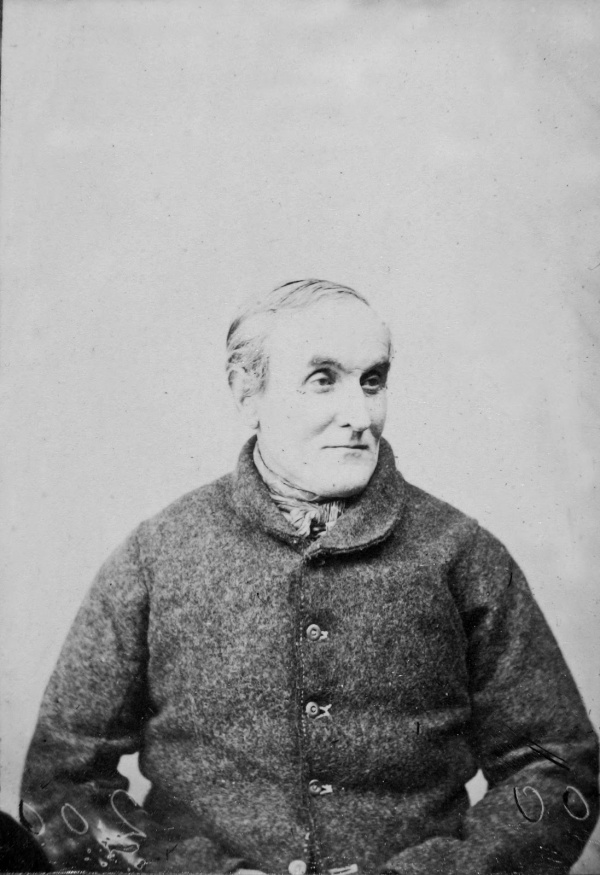
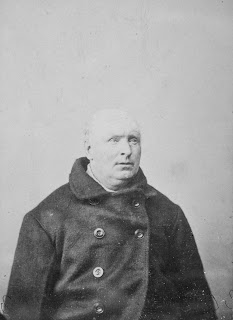
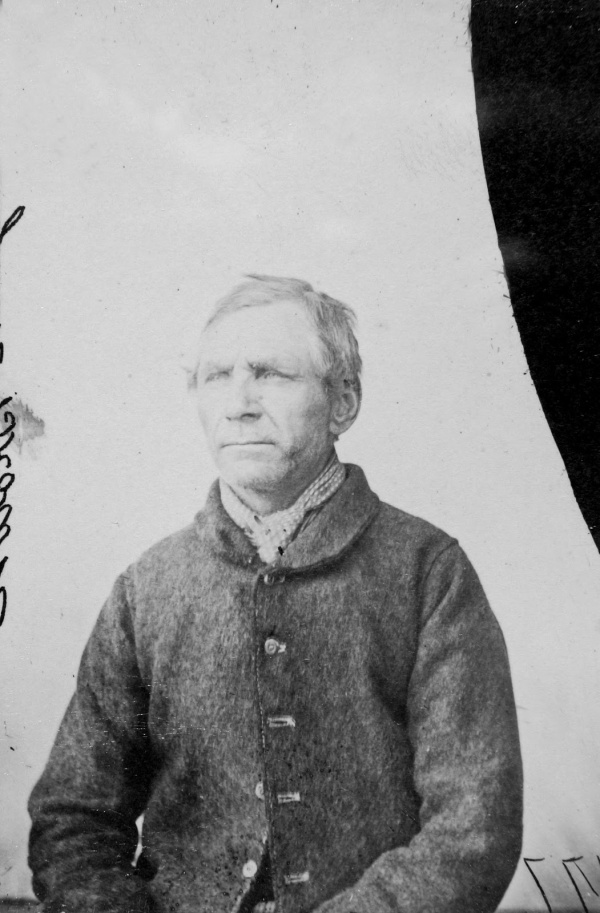
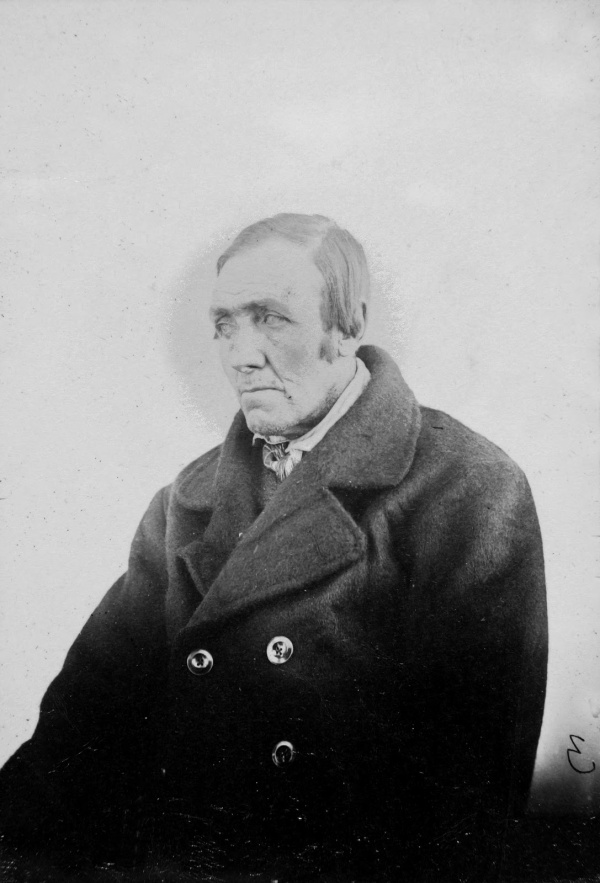
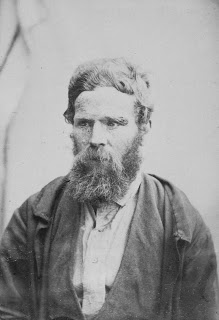
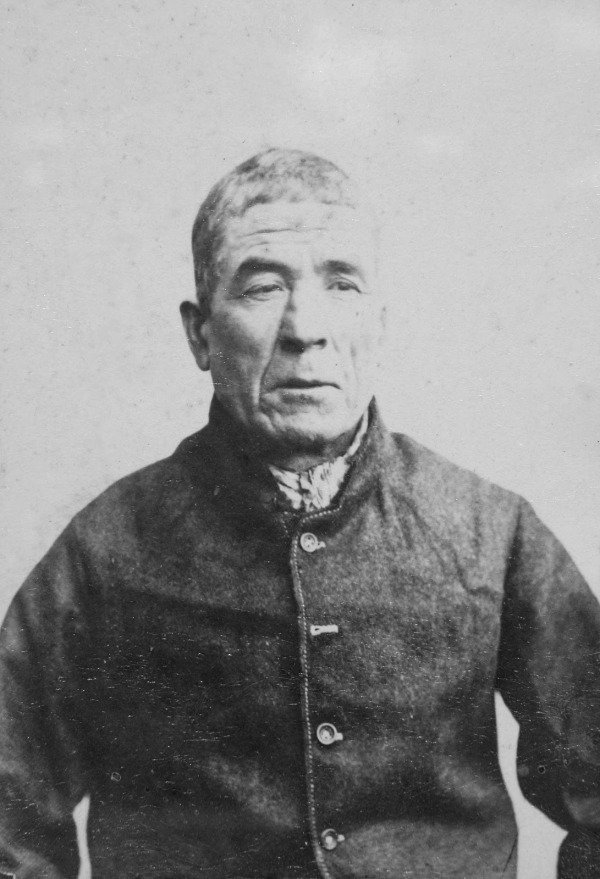
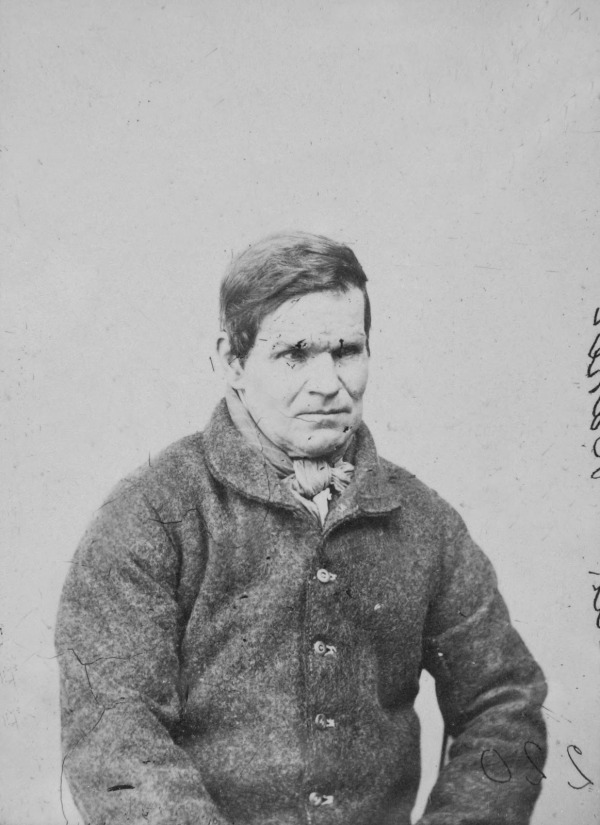
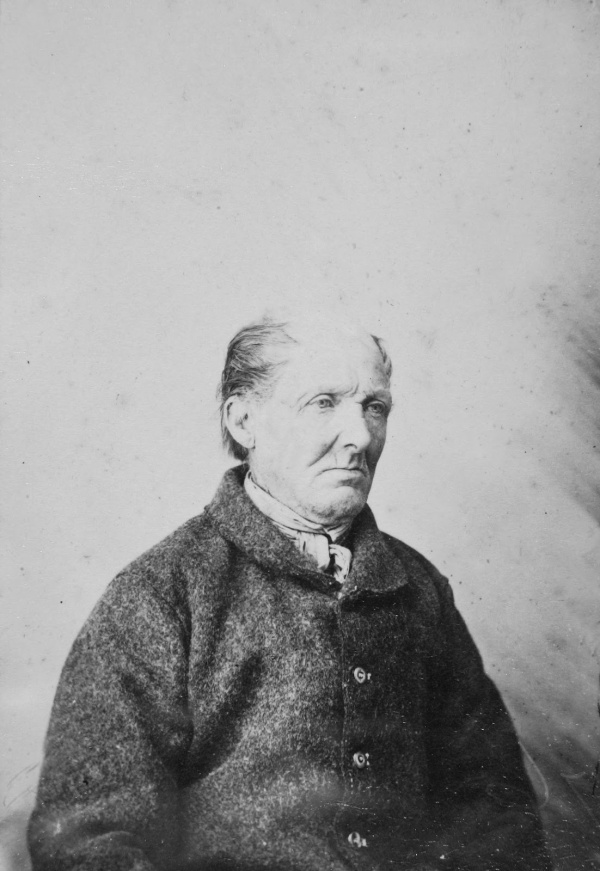
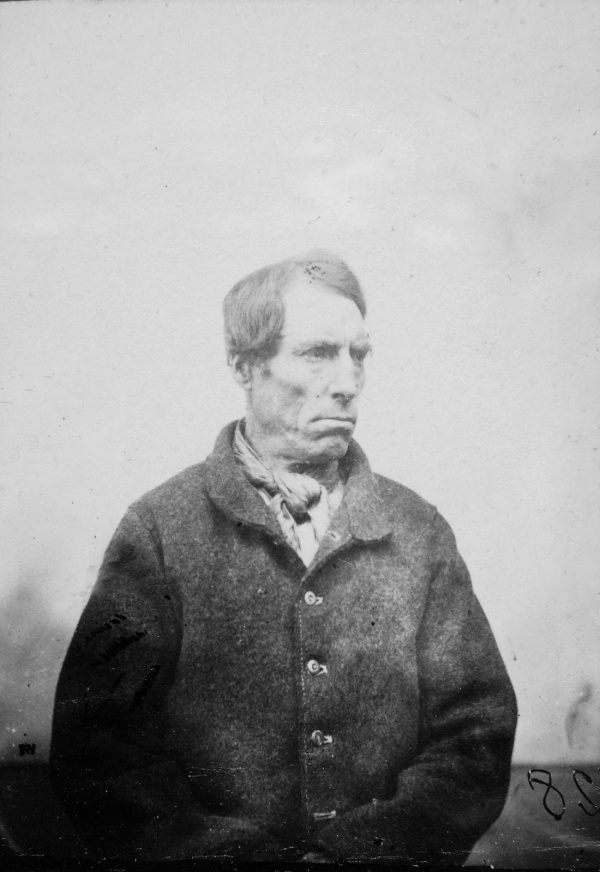
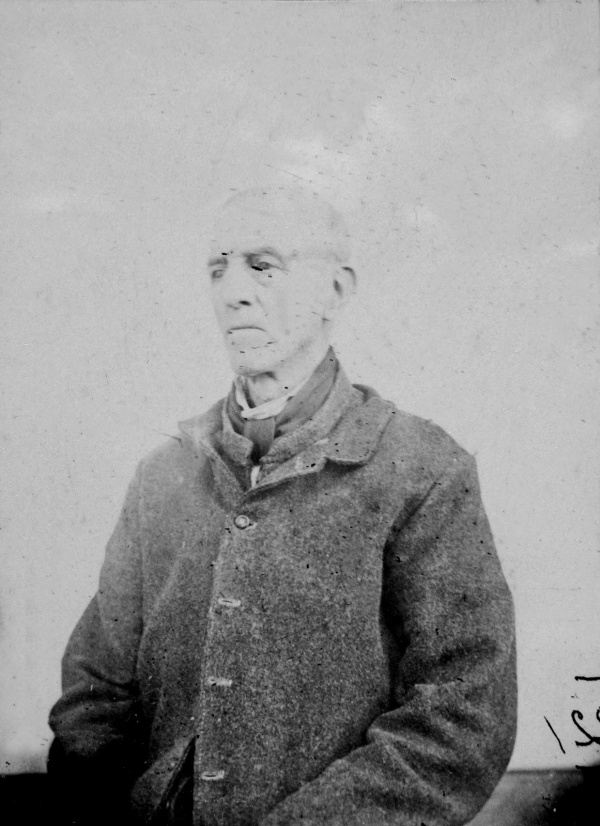
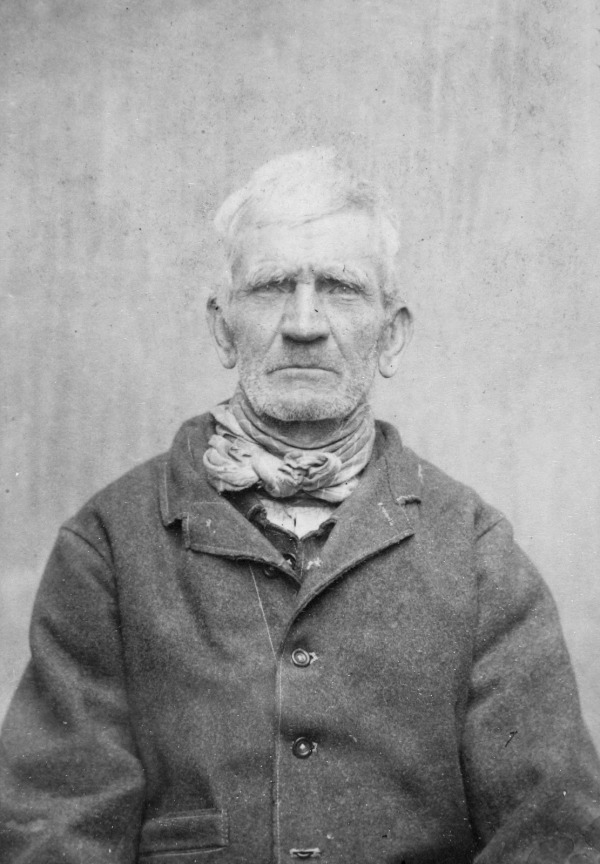
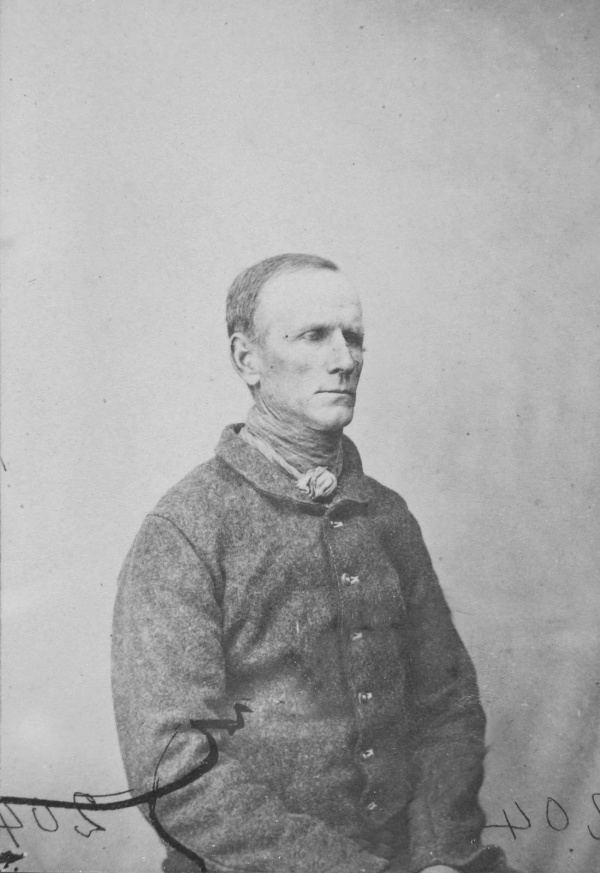
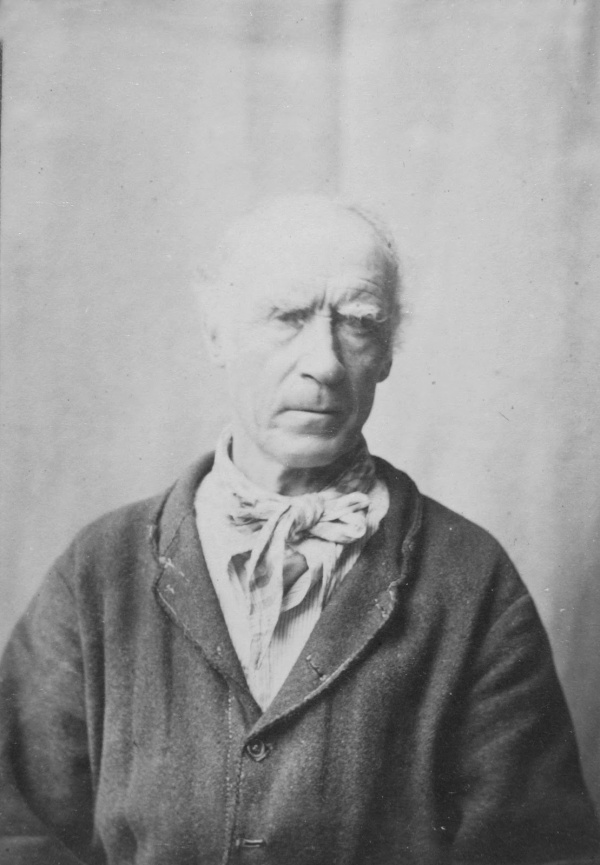
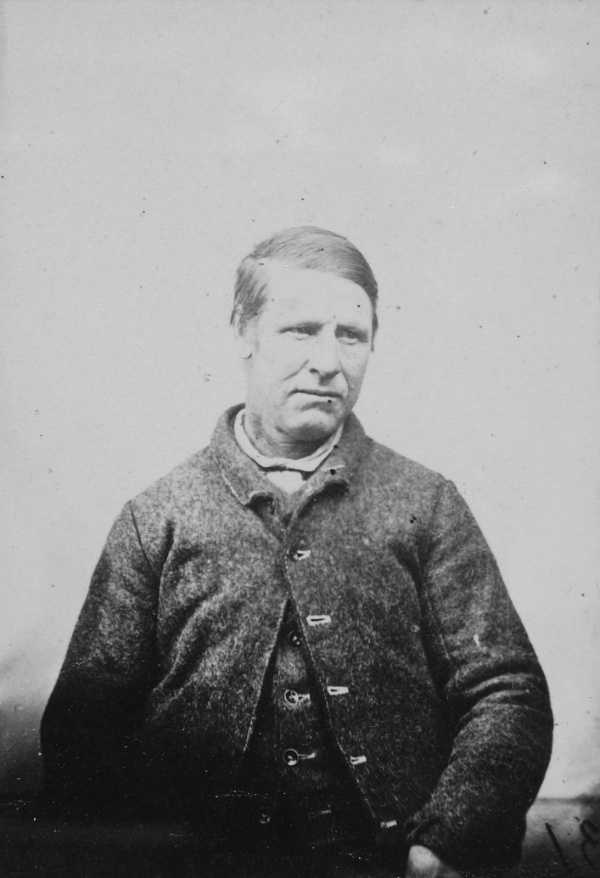
Chris Long's cleaned-up black & white reprints from Nevin's 1870s sepia prints,
Reproduced in 1985 at the QVMAG.
Photos by Thomas J. Nevin (1842-1923)
QVMAG Collection Launceston Tasmania
Although these four prisoners below are not identified at the QVMAG, their names appear on the same photograph, either unmounted or printed in an oval mount, held in other public collections; for example, there are more than fifty (50) held at the Tasmanian Museum and Art Gallery, and eighty-four (with duplicates, 87) held at the National Library.There is another group, named in the collection of thirteen prisoner mugshots by T. J. Nevin held in the Mitchell Collection, State Library of NSW,



Unidentified prisoners, Archives Office of Tasmania but identified at the QVMAG.

Unidentified at AOT, identified as Thomas Jackson at QVMAG
RELATED POSTS main weblog
- Crooks Like Us
- Disambiguation: two prisoners called William SMITH
- Prisoner Henry CLABBY and the TMAG frame-up
- Rogues Gallery: National Library of Australia collection
- Rogues Gallery: Tasmanian Museum and Art Gallery Collection
- Thomas Nevin's glass plates of prisoners 1870s
